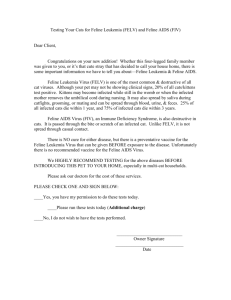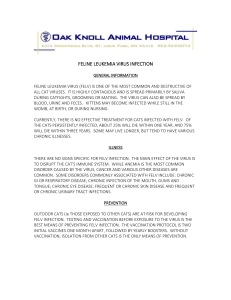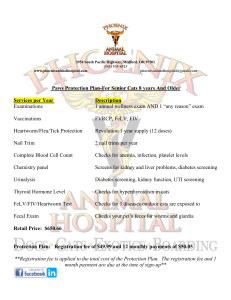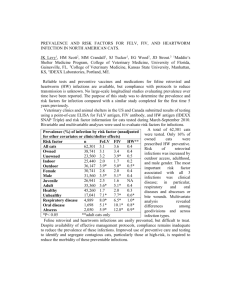An Overview of Feline Viral Disease
advertisement
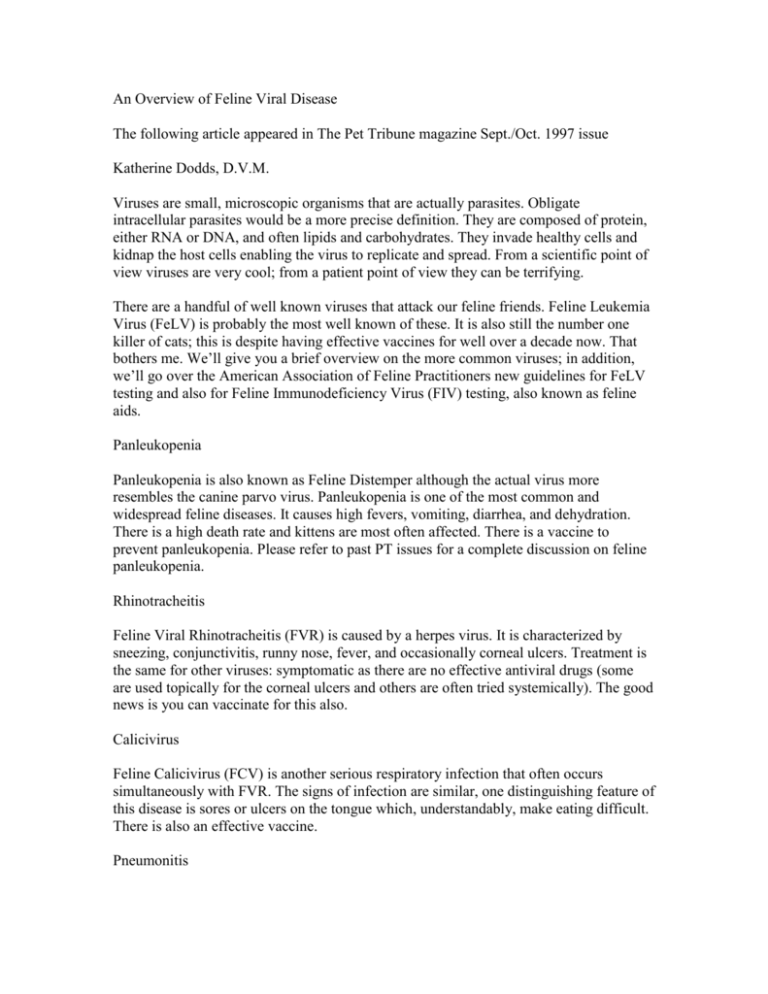
An Overview of Feline Viral Disease The following article appeared in The Pet Tribune magazine Sept./Oct. 1997 issue Katherine Dodds, D.V.M. Viruses are small, microscopic organisms that are actually parasites. Obligate intracellular parasites would be a more precise definition. They are composed of protein, either RNA or DNA, and often lipids and carbohydrates. They invade healthy cells and kidnap the host cells enabling the virus to replicate and spread. From a scientific point of view viruses are very cool; from a patient point of view they can be terrifying. There are a handful of well known viruses that attack our feline friends. Feline Leukemia Virus (FeLV) is probably the most well known of these. It is also still the number one killer of cats; this is despite having effective vaccines for well over a decade now. That bothers me. We’ll give you a brief overview on the more common viruses; in addition, we’ll go over the American Association of Feline Practitioners new guidelines for FeLV testing and also for Feline Immunodeficiency Virus (FIV) testing, also known as feline aids. Panleukopenia Panleukopenia is also known as Feline Distemper although the actual virus more resembles the canine parvo virus. Panleukopenia is one of the most common and widespread feline diseases. It causes high fevers, vomiting, diarrhea, and dehydration. There is a high death rate and kittens are most often affected. There is a vaccine to prevent panleukopenia. Please refer to past PT issues for a complete discussion on feline panleukopenia. Rhinotracheitis Feline Viral Rhinotracheitis (FVR) is caused by a herpes virus. It is characterized by sneezing, conjunctivitis, runny nose, fever, and occasionally corneal ulcers. Treatment is the same for other viruses: symptomatic as there are no effective antiviral drugs (some are used topically for the corneal ulcers and others are often tried systemically). The good news is you can vaccinate for this also. Calicivirus Feline Calicivirus (FCV) is another serious respiratory infection that often occurs simultaneously with FVR. The signs of infection are similar, one distinguishing feature of this disease is sores or ulcers on the tongue which, understandably, make eating difficult. There is also an effective vaccine. Pneumonitis Pneumonitis is caused by Chlamydia psittaci which is a rickettsial organism. These are not true viruses and are on the evolutionary chain between viruses and bacteria. I mention it because there is an effective vaccine and the symptoms are very similar to FVR and FCV. Feline Infectious Peritonitis Known by its more common name, FIP is a leading killer among young and old cats. According to some sources only Feline Leukemia virus kills more cats than FIP and some put the death toll at close to half a million cats each year! It is caused by a corona virus (today’s insignificant trivia is that the name is derived from the corona or crown shape of the virus). If you are a cat lover you surely have heard about FIP. It has 2 forms, a dry and a wet form. The more common symptoms are a swollen abdomen, kidney and liver disorders, central nervous system signs, fever, weight loss, anemia, and anorexia. Thee is no proven treatment and many cats with FIP die. In 1991 a new vaccine was introduced. The vaccine is administered as nose drops and is reported safe; some researchers question just how effective it is at preventing the disease. Since 1991 I have vaccinated thousands of cats for FIP without incidence. Discuss this vaccine with your veterinarian to see if your kitty is a candidate for vaccination. New guidelines for FeLV and FIV Testing The diseases Feline Leukemia and Feline Immunodeficiency Virus are well known to cat owners and have been described in past PT issues. Recently, the American Association of Feline Practitioners/Academy of Feline Medicine (AAFP/AFM) has made some new recommendations regarding these 2 viruses. FeLV The status of all cats should be known. Kittens can be tested at any age and should be screened before introducing a new kitten into your cat family. Carriers do exist and should be identified as well. At risk cats (ie. outdoor, strays, fighters, breeders etc) should be tested every year; this is considered justifiable! Vaccination is strongly recommended and does not interfere with subsequent testing. An ELISA blood test (not saliva or tears) is the preferred screening test; this tests for p27 protein in the serum. If negative and there is no known exposure you need not retest. If negative and your cat has been exposed to a known or suspected positive cat have it retested again in a few weeks (this may be positive) and finally again in 90 days. If negative in 90 days you are fine. If your cat tests positive on the ELISA test an IFA test is used to confirm and stage the infection (ie. carrier, exposed, ill). If IFA positive you should have both the ELISA and IFA assays repeated at 4-8 week intervals. Remember no test is 100% accurate at all times so you should never make a critical decision based on a single test result. If you think this is all confusing imagine how we doctors felt. We thank the AAFP/AFM for these long overdue guidelines! FIV Testing is the only means of controlling FIV; there is no vaccine. It is also a worldwide virus and we think it is more common than we know about! In contrast to FeLV, FIV should not be tested for in cats less than 6 months of age; this is because antibodies from the mother can interfere with the results. A positive or negative result in a cat less than 6 months of age should be retested after 6 months of age. Guidelines for who should be tested are identical for FeLV (ie. at risk cats, new cats to households etc). FIV is also screened using an ELISA blood test; a positive test should be confirmed via a Western Blot test. Positive cats should be retested in 120 days. Just as with FeLV, at risk cats should be checked yearly. The prognosis for FIV positive cats is better than it is for FeLV positive cats, and many can live healthy for months to years. Many of the viruses that attack our cats can be controlled through vaccination and testing. Even though multiple vaccinations have come under scrutiny in the past few years we cannot forget the progress we have made against deadly viral diseases for which there are no cures. I think all of us would like to practice a more naturalistic, holistic style of medicine; let’s just make sure we don’t take any steps backwards!

